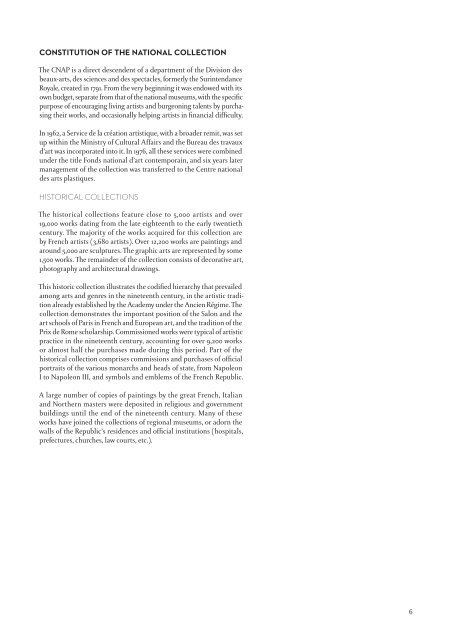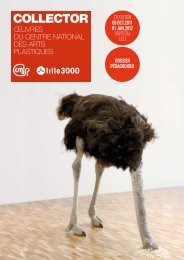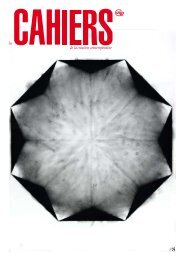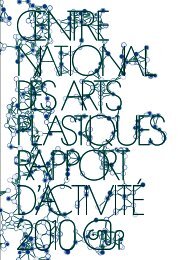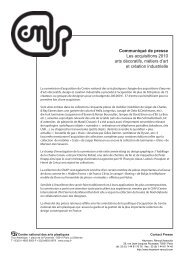Centre national des arts plastiques - Cnap
Centre national des arts plastiques - Cnap
Centre national des arts plastiques - Cnap
You also want an ePaper? Increase the reach of your titles
YUMPU automatically turns print PDFs into web optimized ePapers that Google loves.
CONSTITUTION OF THE NATIONAL COLLECTION<br />
The CNAP is a direct <strong>des</strong>cendent of a department of the Division <strong>des</strong><br />
beaux-<strong>arts</strong>, <strong>des</strong> sciences and <strong>des</strong> spectacles, formerly the Surintendance<br />
Royale, created in 1791. From the very beginning it was endowed with its<br />
own budget, separate from that of the <strong>national</strong> museums, with the specific<br />
purpose of encouraging living artists and burgeoning talents by purchasing<br />
their works, and occasionally helping artists in financial difficulty.<br />
In 1962, a Service de la création artistique, with a broader remit, was set<br />
up within the Ministry of Cultural Affairs and the Bureau <strong>des</strong> travaux<br />
d’art was incorporated into it. In 1976, all these services were combined<br />
under the title Fonds <strong>national</strong> d’art contemporain, and six years later<br />
management of the collection was transferred to the <strong>Centre</strong> <strong>national</strong><br />
<strong>des</strong> <strong>arts</strong> <strong>plastiques</strong>.<br />
HISTORICAL COLLECTIONS<br />
The historical collections feature close to 5,000 artists and over<br />
19,000 works dating from the late eighteenth to the early twentieth<br />
century. The majority of the works acquired for this collection are<br />
by French artists (3,680 artists). Over 12,200 works are paintings and<br />
around 5,000 are sculptures. The graphic <strong>arts</strong> are represented by some<br />
1,500 works. The remainder of the collection consists of decorative art,<br />
photography and architectural drawings.<br />
This historic collection illustrates the codified hierarchy that prevailed<br />
among <strong>arts</strong> and genres in the nineteenth century, in the artistic tradition<br />
already established by the Academy under the Ancien Régime. The<br />
collection demonstrates the important position of the Salon and the<br />
art schools of Paris in French and European art, and the tradition of the<br />
Prix de Rome scholarship. Commissioned works were typical of artistic<br />
practice in the nineteenth century, accounting for over 9,200 works<br />
or almost half the purchases made during this period. Part of the<br />
historical collection comprises commissions and purchases of official<br />
portraits of the various monarchs and heads of state, from Napoleon<br />
I to Napoleon III, and symbols and emblems of the French Republic.<br />
A large number of copies of paintings by the great French, Italian<br />
and Northern masters were deposited in religious and government<br />
buildings until the end of the nineteenth century. Many of these<br />
works have joined the collections of regional museums, or adorn the<br />
walls of the Republic’s residences and official institutions (hospitals,<br />
prefectures, churches, law courts, etc.).<br />
6


